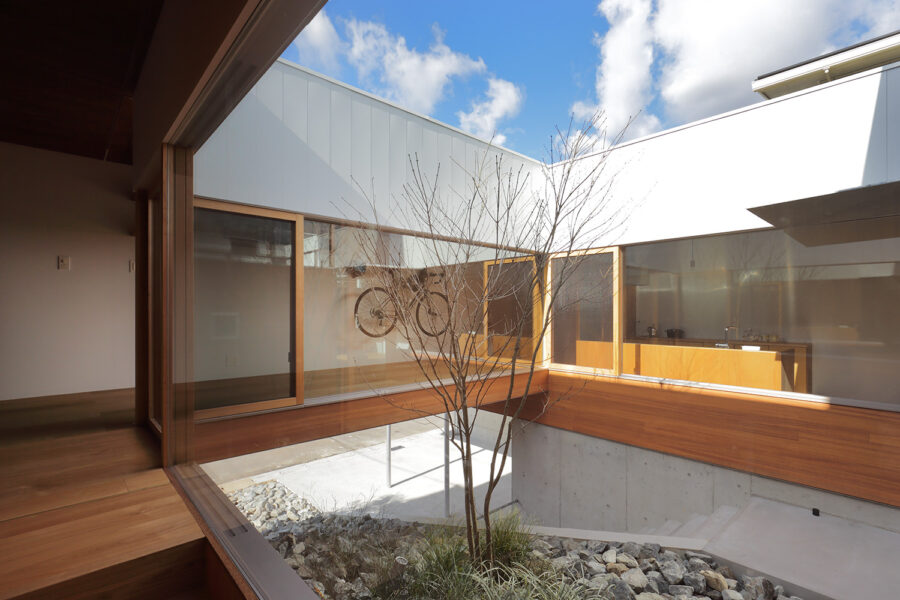商品や雑誌などの撮影を、住宅のシーンで撮るための写真スタジオである。
住宅におけるそれぞれのシーンを、既存倉庫の鉄骨躯体の下に、自立した木造平屋の建物として1つに構築することが求められた。スタジオに求められるのは、まず南からの光であり、既存の東西に長い建物の平面を、南北方向に凸凹させることで、角度を振った長い距離での撮影が可能になるようにして、平面が決まっていった。
仕上げは数年おきに変わる可能性があるということだったので、入隅を撮影スポットとするL字の壁を、建具で見切りながらつなげている。撮影のために求められていた高さ2.7メートルの壁の頂部には、笠木的に写真を見切る小さな天井がまわっていて、それより上は採光層として存在している。
スタジオに付随して、モデルのためのメイクルームがあり、本体と既存躯体との間は非空調の半屋外空間で、撮影スポットとして仕上げられているところと、倉庫然とした空間が併存している。
当初、木造住宅の規格寸法に基づいて構造を提案していたが、撮影する際にカメラマンの背後に控えるクルーたちの居場所などを考えていくうちに、そのスパンが5メートルを越え、成立が難しくなった。このようなとき、設計者がとるべき態度として、集成材を選ぶのが合理的だ。だが、経済成長期における木材の伐採および植林から60年以上が経ち、山に四寸角(120ミリ角)の柱が十分に採れる径をもった原木が多数あるという現状を鑑み、資源ありきで設計を考えると、選択は集成材であるべきではない。
そもそも、木造という構法を考えてみれば、材ごとに強度は異なり、いわゆる狂いも生じる。さらには割れることもある。構造的には、木造は決して合理的とは言い難い。その代わり、素材としての木の温かみや吸湿性、断熱性、可塑性といった、多義的な側面があることが、木造という構法が構造形式を越えて現代的なところであり、こうした多義性を最大化するべく、3メートルから4メートルの長さがある四寸角の流通材を12本束ね、構造的に冗長性のある“重ね梁”とし、採光層に現すことにした。
元々あった倉庫の架構を作業場に見立て、製材所から直接届いた四寸角の流通材約230本を、その場で手刻みで加工し、組み上げた。
木材を積み重ねて長いスパンを持ち出すという手法は、日本では古くは法隆寺建造の頃からなされてきたという。また、アメリカの美学史学者・ジョージ・クプラー(George A. Kubler 1912-1996)は、1962年に著した書籍『The Shape of Time: Remarks on the History of Things』の中で次のように述べている。
「文化の束は、出来事という繊維状のさまざまな長さの期間で構成される。(中略)それらはほとんど偶然によって並べられ、意識的な将来への展望や緻密な計画によって並べられることは滅多にないのである。」
※参照元:『時のかたち──事物の歴史をめぐって』中谷礼仁・田中伸幸訳 鹿島出版会 SD選書 2018年刊
四寸角のみでつくられた架構は、4号建築として確認申請が可能な躯体となっている。この国の森林資源や流通の現状を鑑みて、歴史の中に積み上げられてきた試みを、明るい未来のために並べ直すこと。それは、僕らがすべてのプロジェクトを通じて行っていることであり、本稿とは別の事例となるが、埼玉県産の西川材の無垢材を使った〈垂木の住宅〉シリーズなどは、その1例である。(富永大毅)
A photography studio with 120mm square cross-sections in the lighting layer
Each residential scene was designed as a freestanding, single-story wooden building under the steel frame of an existing warehouse. The studio was required to be built in The studio was first required to be lit from the south. A north-south direction replaced the existing long east-west plan of the building By making it uneven at the top and bottom of the screen, and it is possible to shoot at long distances at varying angles so that the plane is fixed and I went.
The finishes could change every few years, so the L shape with the entrance corner as a shooting spot. The walls of the building are connected with fittings, looking out of the way. At the top of the 2.7-meter-high wall, which was required for the photoshoot, a small The ceiling goes around, and above it exists as a lighted layer.
Accompanying the studio is a make-up room for the models, and the space between the main body and the existing structure is non-air-conditioned and half-heated. It’s an outdoor space with a combination of spaces that have been made to look like a shooting spot and warehouses.
Initially, the structure was proposed based on the standard dimensions of a wooden house. When shooting, the photographer was behind the As I thought about the whereabouts of the crew members who were to be waiting for it, and so on, the span of that span exceeded five meters, and the establishment It has become difficult. The reasonable attitude for designers to take at such times is to opt for laminated wood. However, more than 60 years after the cutting and planting of timber during the economic growth period, a 4″ square (12 Because there are many logs with a sufficient diameter for a post (1.5 cm square), we designed the system based on the resources available. The choice should not be laminated wood. In the first place, considering the construction method of timber, each piece of wood’s strength is different, and so-called madness can occur, and Split. Structurally, wood is by no means a reasonable choice. Instead, there are multiple aspects of wood as a material: its warmth, moisture absorption, insulation, and plasticity. It is where the wooden construction method is modern beyond the structural form and maximizes this ambiguity. A bundle of twelve 4″ square pieces of distribution material, ranging from three to four meters in length, is structurally redundant.” I decided to use “stacked beams” and show them in the lighting layer.
The original warehouse structure was used as a workshop, and about 230 4cm² blocks delivered directly from the sawmill were used to make the structure. It was hand-chopped and assembled on the spot.
The technique of stacking wood to create long spans has not been used in Japan since the construction of the Horyu-Ji Temple. It is said to have been done. The American aesthetic historian George A. Kubler (1912-1996) states in his book “The Shape of Time: Remarks on the History of Things” thet publushed 1962.
‘A bundle of cultures is composed of periods of varying lengths in the form of fibers of events arranged mostly by chance. …they are arranged almost by chance, by the conscious vision and elaborate planning. They are seldom lined up.’
*Reference source: “The Shape of Time: About the History of Things” Translated: Norihito Nakatani and Nobuyuki Tanaka, KAJIMA INSTITUTE PUBLISHING CO., LTD. 2018
The frame, made entirely of four square feet, is a frame that can be applied for certification as a No. 4 building. In view of the current state of forest resources and distribution in this country, this is a bright future for the project, a trial that has been built up throughout history—reordering for. That’s what we do throughout all of our projects, and it’s a separate case from this paper The “Rafted Wood House” series, made of solid Nishikawa wood from Saitama Prefecture, is one example. (Hiroki Tominaga)
【四寸角の写真スタジオ(スタジオバジル)】
所在地:東京都北区志茂3-6-1
用途:スタジオ
クライアント:スタジオバジル
完成:2019年
設計:TATTA 富永大毅建築都市計画事務所
デザインチーム:富永大毅、藤間弥恵
構造設計:川田知典構造設計
大工:平野屋工務店
空調・電気:原田電機
衛生:C-ONLY
施工:AI建築都市計画事務所
撮影者:中山保寛 / 中山保寛写真事務所
工事種別:リノベーション
構造:既存 鉄骨造、新規間仕切り:木造
規模:1階
建築面積:766.66m²(新規間仕切り範囲:202.57m²)
延べ床面積:766.66m²(新規間仕切り範囲:202.57m²)
設計期間:2018.07-2019.01
施工期間:2019.02-2019.05
【Photo Studio with 120mm square timber】
Location: 3-6-1 Shimo, Kita-ku, Tokyo, Japan
Principal use: Studio
Client: Studio Basil
Completion: 2019
Architects: TATTA
Design team: Hiroki Tominaga, Yae Fujima
Stracture plan: Kawata Tomonori Structural Engineers
Carpenter: Hiranoya building contractor
Air Condition・Electric: Harada Electric
Hygiene: C-ONLY
Contractor: AI Architecture Metro Planning Office
Photographs: Yasuhiro Nakayama / Yasuhiro Nakayama photo agency
Main structure: Steel(New-partitions: Wood)
Building scale: 1 stories
Building area: 766.66m²(New partitioning area: 202.57m²)
Total floor area: 766.66m²(New partitioning area: 202.57m²)
Design term: 2018.07-2019.01
Construction term: 2019.02-2019.05








